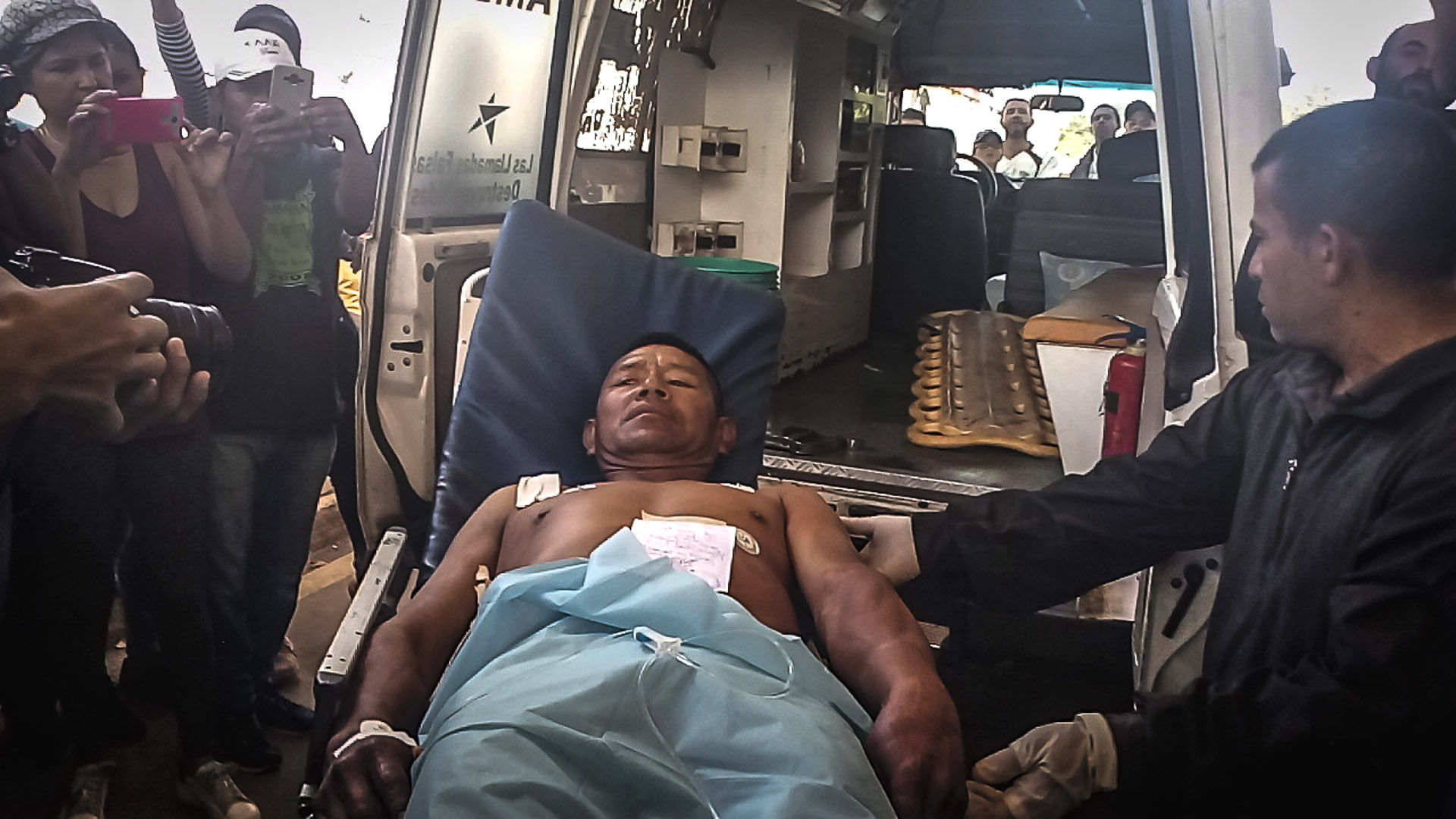

In the early hours of Friday February 22, Venezuelan soldiers arrived at the border with Brazil and opened fire on a group of Pemon who were preparing for the entrance of humanitarian aid. The resulting death of one woman and multiple injuries would be just the beginning of a weekend in which dozens of people were injured and others died from the repression perpetrated by soldiers and armed civilians against members of this ethnic group. Jhoalys Siverio was in Santa Elena de Uairén and offers us her account of the events.
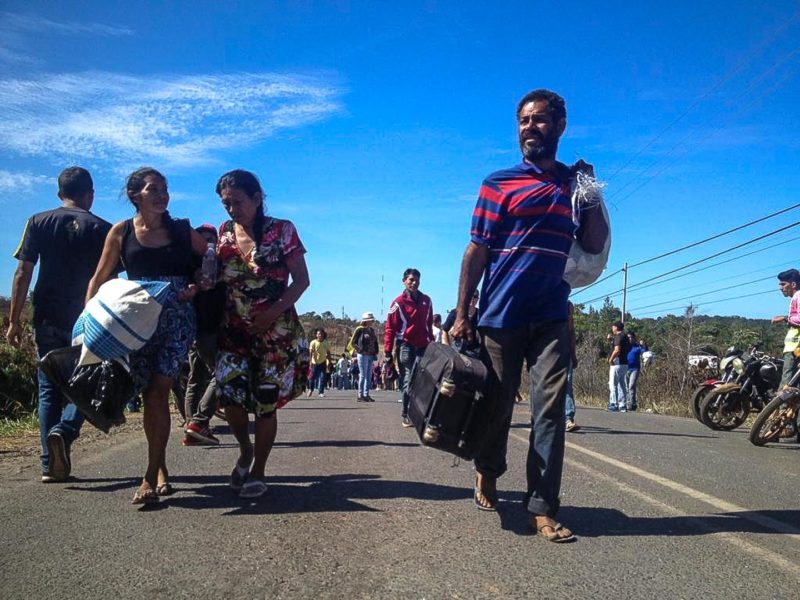
Photography: Marcos Valverde (Crónica Uno)
“They opened fire on our people and a woman has just died!”
“What happened?”
“The convoys came and the guys blocked the road, so they got out and faced us, they shot to kill. There are many injured and we have no way to move them. Call the mayor, please! We need help!”
Carmen Elena could not stop sobbing. She had just seen how one of her Pemon sisters had been assassinated by the Venezuelan Army, and another 15 members of her indigenous community were at risk of losing their lives.
The night before, Thursday February 21, I had met Carmen Elena and her husband Richard, the chief of the Kumarakapay indigenous community, in San Francisco de Yuruaní, an hour from Santa Elena de Uairén, in the south of Bolívar State. On the Saturday, aid was due to enter across the border with Brazil. They assured me that they would defend the passage of that aid, that they desperately needed it after a decade of a walk-in clinic without medicine, without dressings, sometimes even without cotton wool.
The next morning, the WhatsApp messages kept warning about a military attack in Kumarakapay, so I called the chief to confirm. It was Carmen Elena who answered. While I listened to her, shaken, I remembered her face with its calm yet attentive gaze. She is a heavyset woman, not very tall, and with light brown hair. We had exchanged numbers to stay in contact.
If there is one thing that the indigenous do not forgive, it’s the spilling of their blood. The officers who shot at them ran away, but the same morning of the assassination a group took four other members of the Bolivarian National Guard (Guardia Nacional Bolivariana or GNB) into custody. It was a pressure tactic to demand justice and, sure enough, the leader of the GNB in Bolívar State, José Montoya, went to the site to confirm what had happened.
The community was not yet inflamed. They were gathered under an awning at the entrance to the community, just by the control point of the Pemon Territorial Guard, the autonomous self-defence group founded by this ancestral ethnic group to protect indigenous territories. The majority were sat on a row of chairs, with a desk in front, on which the bullets that had been collected, tear gas canisters and some arrowheads were displayed. Opposite, on another three seats, were Montoya and two other low-ranking soldiers. Their fingers were laced together as if they had been told off. They didn’t show fear, but resignation. The commander’s face partially revealed something. In the avenue, there was a GNB vehicle with its tyres punctured, its engine visible and its windows broken.
All the power and force that usually filled that olive green uniform had evaporated. None of the citizens he had repressed in the protests over the years would ever have believed that there was such a submissive, quiescent Brigadier General sat before those Pemon.
Some fellow journalists observed him from the front row. Montoya did not even look up as the Pemon Territorial Guard made claims against him. He even seemed scared when they asked him for the keys to the Jeep he used to get around. He promised them that he wouldn’t leave, to stop them taking the car keys. The other four officers were already in custody, and he would be no exception if he tried to be clever, although later we would find out what he was thinking.
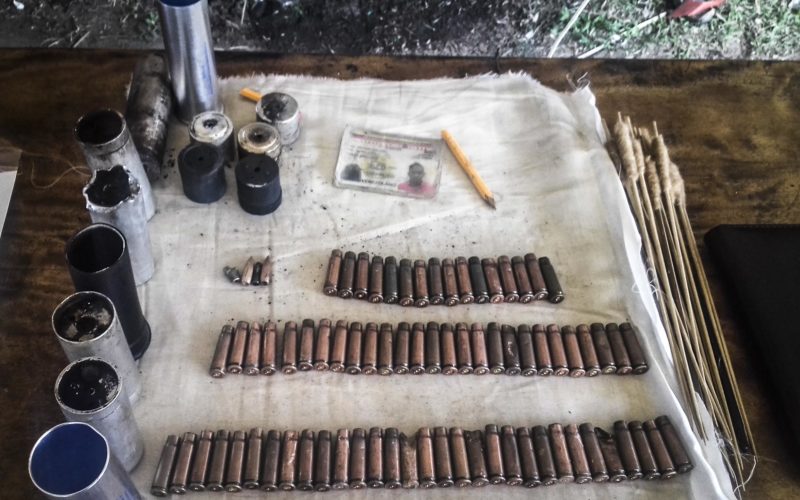
Photography: María Ramírez Cabello
Meanwhile, in Santa Elena de Uairén, the wounded began to arrive at mid-morning. They counted them one by one and they were 15. At least seven had to be taken to an emergency hospital in Boa Vista – three hours away, in Brazil – due to the lack of supplies in the Rosario Vera Zurita Hospital in Santa Elena de Uairén.
The road to Brazil was closed at the height of Fort Roraima, a military base that is about 9 kilometres from the Las Banderas monument. A day earlier, Nicolás Maduro had given the order to close the border. And I was there when the first three ambulances passed. In one of them was Rolando García, the husband of Zoraida Rodríguez, the woman they had killed that morning in the military attack in Kumarakapay. He resisted for several days, but finally died on March 2, due to the seriousness of the injuries he received.
“They came to kill, they took us by surprise, and they killed my aunt,” said Uwer, Zoraida’s nephew, speaking to the press outside the hospital. “We got up to receive humanitarian aid, not to have problems with the military. We have proof that the military attacked us and took us by surprise, we need justice.”
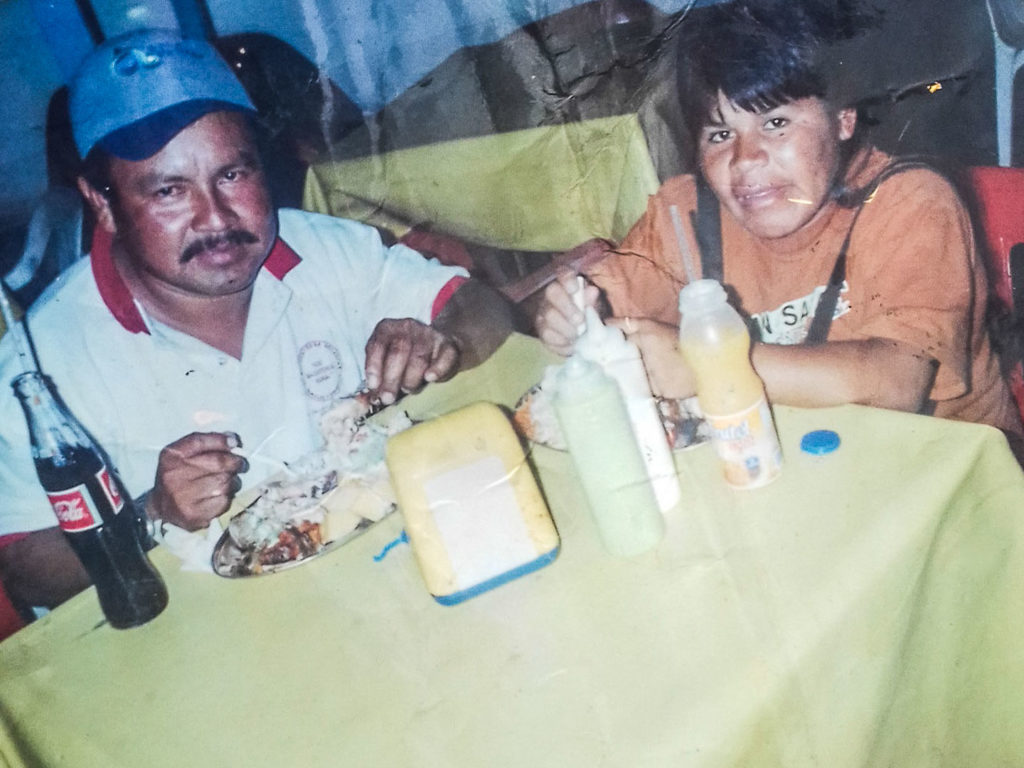
Photography: María Ramírez CabelloZoraida’s body was still in the community, but Uwer was helping with the transfer and care of the wounded.
Zoraida had a food stand outside her house. She came out in the middle of the gunfire to beg for a ceasefire when she was shot. Her husband tried to protect her and was also injured. They said that everything happened between 2 and 3 in the morning, but the police report says that it was after 6 a.m., in a “confrontation” with a commission from the Integral Defence Zone in Bolívar State, even though there were no injuries or deaths among the military.
There had been a state of calm Santa Elena de Uairén all week, until that day. The indigenous and non-indigenous – called criollos – gathered at the Escamoto Motorized Cavalry Squadron, at the height of Fuerte Roraima. If they had wanted to, they could have torn down the military barricade. There were few officers for the number of people who came to protest Zoraida’s murder and to demand that they open the border and let in humanitarian aid. That afternoon, the soldiers who were there showed no signs of trying to attack the demonstrators. The tear gas bombs were thrown towards the forest, not directly at the people, seeking to disperse the crowd.
“Many of them are from here (Santa Elena de Uairén), and they know us. Those who are firing are those from outside, who do not mind killing us,” commented a woman who was in the middle of the protest. Although they were thrown to the sides, one of the tear gas bombs hit one of the protesters in the face.
If the military did not attack and the demonstrators outnumbered them, why didn’t they tear down the military barricades? Because behind them were armed civilians, also Pemon, but from the Mapaurí community, and followers of Nicolás Maduro. They came armed with stones, ready for conflict.
Thus, that Friday, February 22, was just the beginning of what the town of Santa Elena would experience.
The tension rose on Saturday 23. Would the trucks carrying medicine and food from Brazil be allowed to enter or not? What would the Pemon do?, we all asked ourselves, paying attention to what was also happening in Cúcuta, on the border with Colombia, which was where all of the world’s attention was directed on this historic day of humanitarian aid for Venezuela.
As the hours passed, more and more people gathered on either side of the Escamoto: indigenous, criollos and inhabitants of other parts of the country. Some members of the National Assembly were there too.
The repression began at midday.
The indigenous chavistas, armed with stones, bows and arrows, remained on the site. Those who knew them said they also carried guns. The passage was opened for 10 or 15 minutes, and then they closed it. The National Guard stayed away until they complied with the order, now given, to repress the crowd.
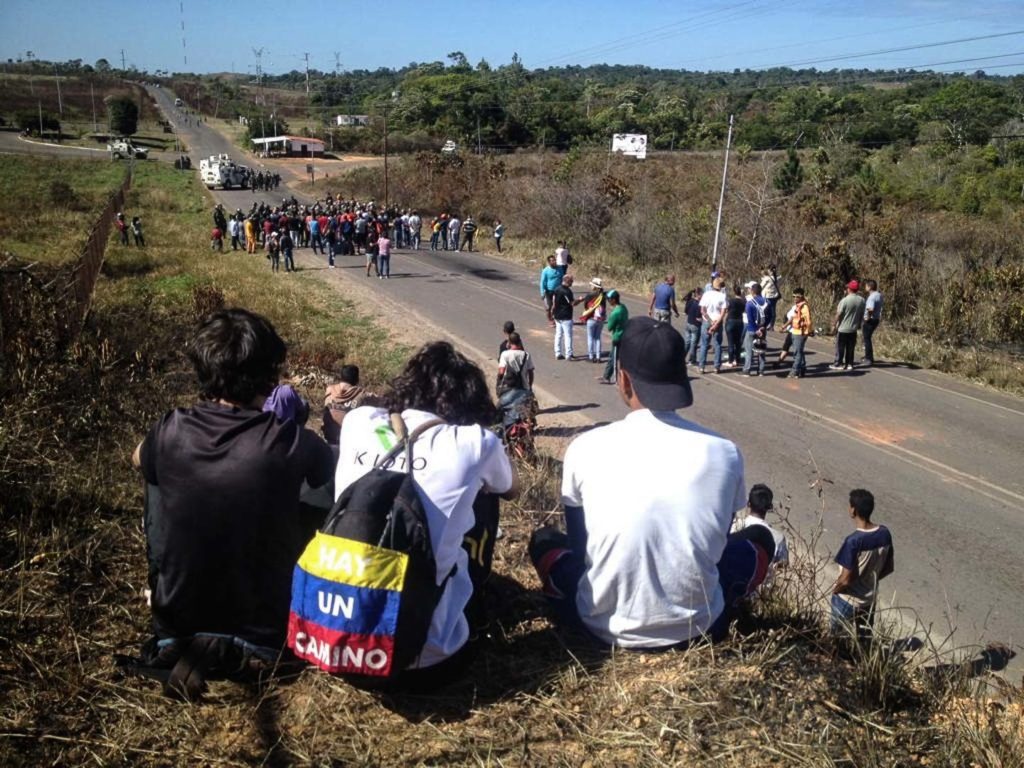
Photography: Marcos Valverde (Crónica Uno)
The tanks moved towards the crowd and collided with a vehicle. After each tear gas bomb, everyone ran to avoid the gas, since most people did not have vinegar, water with bicarbonate or antacid to neutralize its effect. The tanks advanced to force people to retreat. The bombs began to fall further and further, almost reaching the protesting group, which, as a precaution, kept away from the line of fire. The protesters defended themselves by throwing paint at the tanks to limit their visibility, and throwing Molotov cocktails at them.
“If they throw bombs, so will we. We have to defend ourselves, but we have to open the passage,” I remember hearing an indigenous woman say.
Soon the shots could also be heard. We four journalists and the cameraman who was there asked ourselves if they were bullets or pellets. In any case, we sensed that they were on the air because there were still no injuries, only those suffocated by the tear gas. Every so often there was a stampede when the shots were longer and sounded closer, and then we ran for fear of getting hurt.
“We should go, let’s not get caught in the crossfire. They can block us and not let us out,” I told my colleagues and we walked towards the van, ready to leave.
We stayed a few more minutes watching what was happening, wondering if they would tear down the military barricade. But no, the shots were getting closer and we saw what minutes earlier another indigenous person had warned us about.
“They’re waiting, because they’re going up the mountain to shoot at us from all sides. They are going to ambush us.”
When we got into the truck, they were firing from exactly where we had been warned they would. And at that moment the wounded began to fall. With the truck in motion, we saw that one of them was being transported by motorcycle, passed out between the driver and another young man sitting behind him who was holding him. He was about 20 years old, his shirt was bathed in blood, a trickle of red also running from his head. He was the first to enter the hospital, but I didn’t find out if he was one of the deceased that day.
The news began to spread quickly. Outside the hospital, about 11 minutes from where the ambush had occurred, crowds began to gather. Some were recording videos, others were crying out of concern for each wounded person who arrived.
“Who is it? Who is it? Is it Jessica?”
One, two, three, four… after 12, I lost count. The next morning the hospital confirmed that 33 wounded had arrived. People with bullet wounds to the head, chest, leg. I saw them. They weren’t just any wounds. Some were brought on a motorcycle, others in pickup trucks and, as they were lowered out, I saw on their clothes the blood bath right where they had received the impact. As some entered, others left for Brazil in emergency ambulances.
That Saturday, three were murdered: one in the Escamoto, one in front of the National Guard Command and one in the Las Cuatro Esquinas neighbourhood, with a bullet in the head. José Hernández, 26 years old.
“They are killing us! It can’t be, they’re just children!”
The three who died that day were not more than 26 years old.
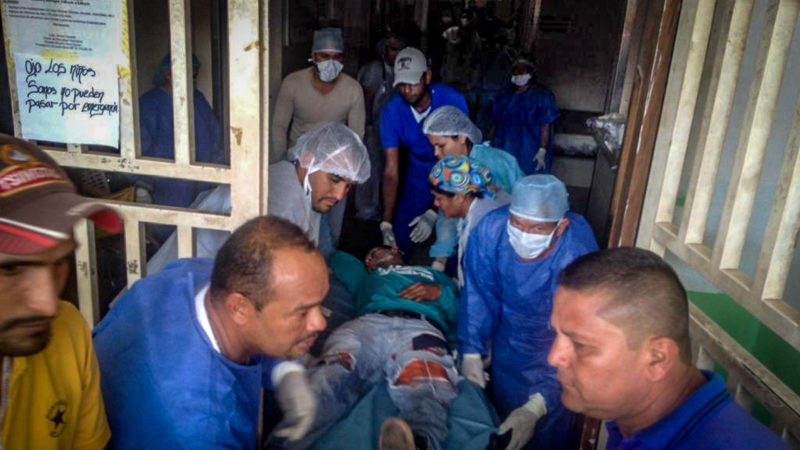 Photography: Marcos Valverde (Crónica Uno)The town was fired up. The barricades returned and with them came military reinforcements with tanks, anti-riot equipment, dozens of Bolivarian National Police trucks, and a score of buses. Everyone wondered if the convicts were coming from El Dorado, the highly dangerous penitentiary located in the Sifontes municipality, a little over four hours from Santa Elena. Many thought that they had been transported there to attack the demonstrators.
Photography: Marcos Valverde (Crónica Uno)The town was fired up. The barricades returned and with them came military reinforcements with tanks, anti-riot equipment, dozens of Bolivarian National Police trucks, and a score of buses. Everyone wondered if the convicts were coming from El Dorado, the highly dangerous penitentiary located in the Sifontes municipality, a little over four hours from Santa Elena. Many thought that they had been transported there to attack the demonstrators.
It was a long night, with the smell of gas and gunfire, near the Santa Elena exit. And in Kumarakapay the tension continued. They were ambushed again late in the afternoon, but this time nine Pemon were detained, including the second captain of the community. This was during the rescue of the soldiers who had been in the custody of the Pemon since Friday morning. The chief and other leaders fled towards the mountain to avoid being captured. “Rafaela sends this message. The order is to kill, we are fleeing up the mountain,” said Candy, the head of the territorial guard, in an audio recording.
In the hotel where I was staying, the shots could not be heard, but you could see the parade of buses, jeeps, tanks and convoys. A GNB truck and a tank remained overnight at the hotel entrance, where some members of the National Assembly were also staying. It was not them they were guarding, but Aristóbulo Istúriz, Minister of Education, and his team. At another hotel, all the politicians and journalists had been made to leave after the arrival of the tanks.
After the murders at Escamoto, the persecution would continue.
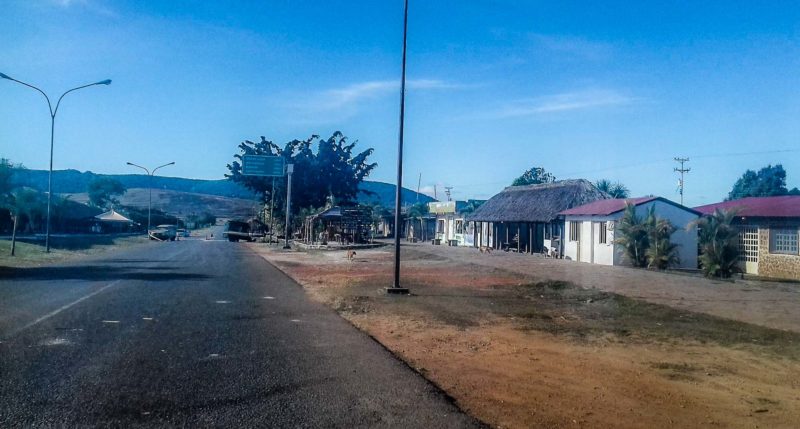
Photography: María Ramírez Cabello
I left Santa Elena de Uairén on Sunday, February 24, heading to Puerto Ordaz. I had to pass through Kumarakapay. I was overwhelmed by the desolation. Not even the Pemon Territorial Guard was at its checkpoint. Everything was closed, no one was on the street, everyone was hunkered down for who knows for how long. Only the National Guard jeep was still there from Friday.
Then I understood what Comandante José Montoya – dismissed from his post on Monday, February 25 – had known, what I had glimpsed in his self-absorption that seemed to be submission to the Pemon: that reinforcements were coming from the Army. And with them 48 hours of arrests, assaults, bullets and deaths.
The hospital was militarized, as were other points in the town. The mobilization of uniformed soldiers did not stop. The people were filled with fear.
“The houses, the lodgings, the hotels are being searched and people are being arrested,” said Francis, a friend that Santa Elena had given me in those days.
On the night of Tuesday February 27, I read a post on Twitter from Deputy Olivia Lozano, which was later confirmed by colleagues in Brazil: Kliver Alfredo Pérez Rivero, a 24-year-old Pemon, had died. He was one of 15 injured in Kumarakapay the early hours of February 22, and one of the 9 transferred to Boa Vista. He was in the Intensive Care Unit of the General Hospital of Roraima, with multiple injuries to the liver and intestines, due to gunshot wounds in the abdomen and chest. Klíver became the fifth mortal victim of those tragic events. A few days later we would learn about the death of Jorge González, who was from Upata and was also in that hospital. With him, the number of dead rose to six.
“This is the first time that this has happened in Santa Elena de Uairén,” several locals told me.
And the persecutions continue.
It’s official, they are there to kill.
With information from Marcos Valverde.
Translation: Katie Brown

Note: This is a story of the Venezuelan website La vida de Nos. It is part of its project La vida de Nos Itinerante, which develops from storytelling workshops for journalists, human rights activists and photographers coming from 16 states of Venezuela.
2934 readings
I am an Andrés Bello Catholic University journalist. I am passionate about writing, reading and hitting the streets, and that’s what I do every single day. I have also found a passion for something that is both a challenge and a learning opportunity: telling stories for you and for me.
2 Comentario sobre “The Bloodshed Which Fired Up the Pemon”